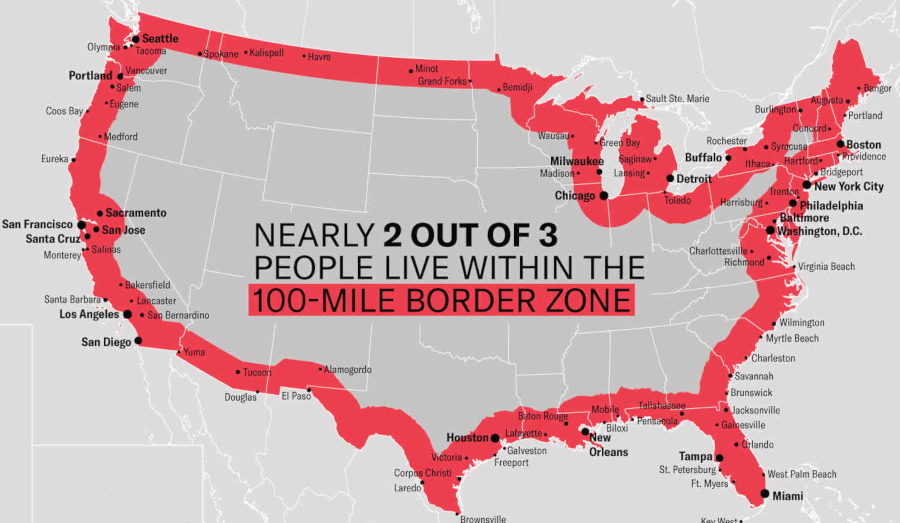
the 100-mile border zone in which Federal agents can establish checkpoints extends west of Richmond
Source: American Civil Liberties Union, The Constitution In The 100-Mile Border Zone

the 100-mile border zone in which Federal agents can establish checkpoints extends west of Richmond
Source: American Civil Liberties Union, The Constitution In The 100-Mile Border Zone
At the start of the Cold War, the Federal government authorized what is now the US Customs and Border Patrol to identify and interrogate people thought to be unauthorized immigrants, or "aliens." The US Code identifies that Federal agents have the authority:1
In 1953, "reasonable distance" was defined as 100 miles from the international border. That distance would allow Federal agents to catch people who had bypassed the screening process when entering the United States. There are five ports of entry in Virginia: Front Royal, New River Valley Airport, Norfolk-Newport News, Port of Washington-Dulles, and Richmond - Petersburg.2
Within the border zone, Border Patrol agents can demand people to "show papers" and prove citizenship. Federal agents have set up checkpoints on highways, and interrogated passengers on domestic trains and buses away from an international border. Border Patrol agents require no warrants to enter private lands within 25 miles of an international border.
The interrogations of travelers, at some distance from the boundaries with Canada and Mexico, has been controversial. Some people consider it to violate at least the spirit of the Fourth Amendment to the US Constitution, which starts with:3
In 1976, the US Supreme Court ruled that the interior checkpoints were legal. They created only minimal intrusion to motorists, "even in the absence of reasonable or individualized suspicion." That applied to both permanent and temporary checkpoints.4
1. 8 U.S.C § 1357(a)(3), US Code, Government Printing Office, https://www.gpo.gov/fdsys/pkg/USCODE-2011-title8/html/USCODE-2011-title8-chap12-subchapII-partIX-sec1357.htm (last checked June 25, 2018)
2. "Inside the Massive U.S. 'Border Zone'," CityLab, May 14, 2018, https://www.citylab.com/equity/2018/05/who-lives-in-border-patrols-100-mile-zone-probably-you-mapped/558275/; "Locate a Port of Entry in Virginia," US Customs and Border Protection, https://www.cbp.gov/contact/ports/va (last checked June 25, 2018)
3. "ACLU Factsheet on Customs and Border Protection's 100-Mile Zone," American Civil Liberties Union, https://www.aclu.org/other/aclu-factsheet-customs-and-border-protections-100-mile-zone?redirect=immigrants-rights/aclu-fact-sheet-customs-and-border-protections-100-mile-zone; "Report: Border Patrol wrongly arrested hundreds in N.Y," USA Today, February 14, 2013, https://www.usatoday.com/story/news/nation/2013/02/14/report-border-patrol-wrongly-arrested-hundreds/1921835/; US Constitutuion, Legal Informatin Institute, Cornell Law School, https://www.law.cornell.edu/constitution (last checked June 25, 2018)
4. "What is the legal authority for the Border Patrol to operate checkpoints and engage in other activities to detect illegal aliens in the United States?," U.S. Customs and Border Protection, November 13, 2015, https://help.cbp.gov/app/answers/detail/a_id/1084/~/legal-authority-for-the-border-patrol (last checked June 25, 2018)